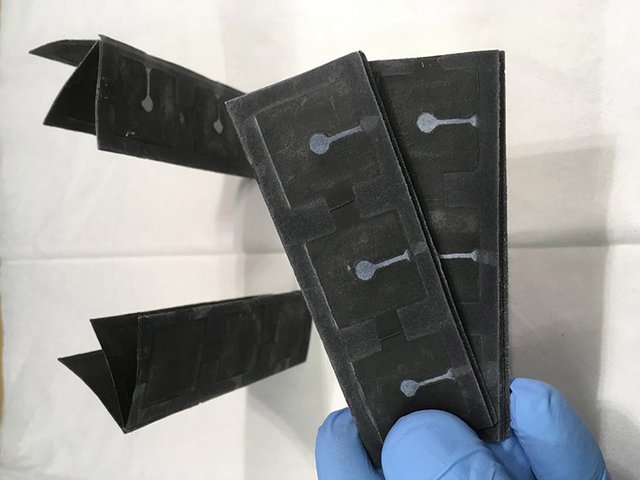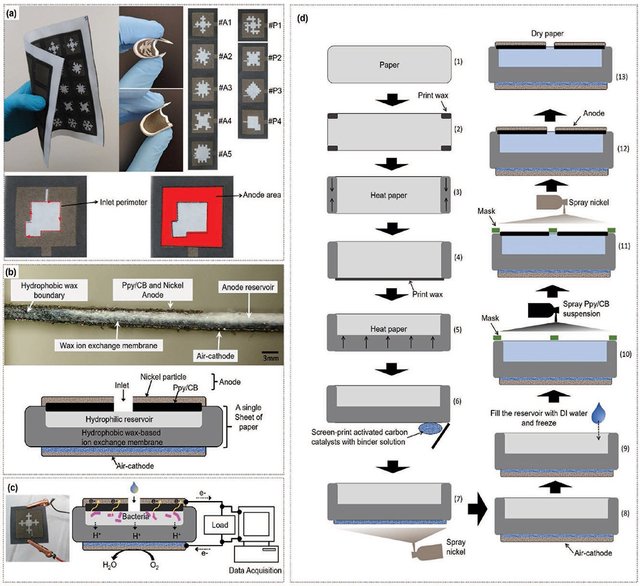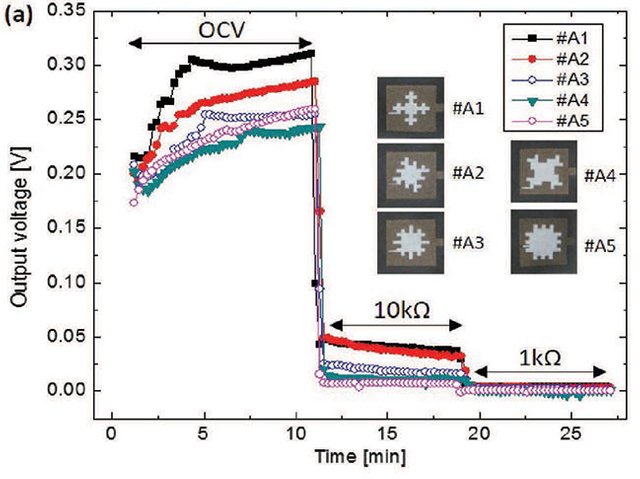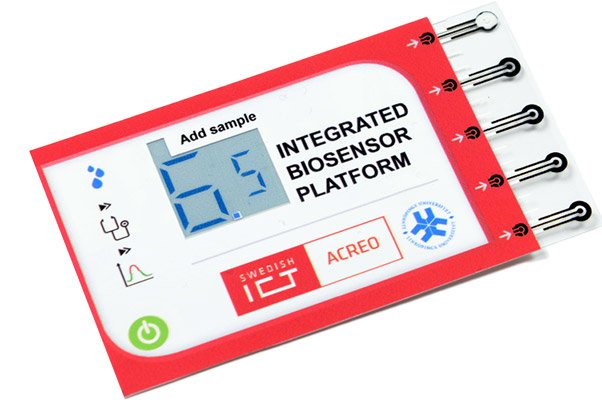A new paper-based microbial fuel cell technology has been constructed from bacteria to power disposable electronics.
This papertronic technology can be bent and stacked into specific shapes to fit into particular devices. This technology reduces fabrication time and cost, and is a more bio-friendly power source for remote and dangerous resource-limited areas.

source
"Stand-alone and self-sustained, paper-based, point-of-care devices are essential to providing effective and life-saving treatments in resource-limited settings," said Seokheun Choi, one of the researchers of this work and director of the Bioelectronics and Microsystems Lab at Binghamton University.

source
Papertronics is a game-changing field for next-generation electronic developments in all aspects of our lives. Paper electronics incorporates both fluid and electronic components giving it the potential to transform our way of life by giving us new functionality, minimizing design and complexity of electronic systems and providing scalability not seen before in electronics.
To create the bacteria powered battery. A ribbon of silver nitrate is placed underneath a thin layer of wax to create a cathode. On the other half of the paper, a conductive polymer is made which acts as the anode. After the paper is properly folded and a few drops of liquid containing the bacteria are added, the cellular respiration of those bacterial microbes powers the battery.

source
The battery works by separating the components it into different layers which are then manually assembled for all the components to link up. This has potential issues due to misalignment of each layer which can decrease the power generated.
Do not expect any large power availability from this tech, at least for now. It would take millions of the paper batteries to power a common 40Watt lightbulb. The point of making these is for disaster situations where usability and portability is more important than having a lot of power that can last a long time.
The specific power generation is 31.51 µW at 125.53 µA with six batteries in three parallel series. A 6 x 6 configuration of batteries yields 44.85 µW 105.89 µA.

source
The power would be enough to run biosensors, such as monitoring glucose levels in diabetes, or detecting pathogens or other life-saving functions.

source
Another thing that makes this microbial fuel-cell technology exciting, is that the microorganisms used can harvest electrical power from any biodegradable source like wastewater. Choi believes "this type of paper biobattery can be a future power source for papertronics" in general.
These findings are further going to be presented at the IEEE MEMS 2017 Conference in Las Vegas, which takes place January 22-26.
Thank you for your time and attention! I appreciate the knowledge reaching more people. Take care. Peace.
References:
- Scientists build bacteria-powered battery on single sheet of paper
- Stepping Toward Self-Powered Papertronics: Integrating Biobatteries into a Single Sheet of Paper
If you appreciate and value the content, please consider:
@krnel
2016-12-21, 4:45pm

Really awesome stuff! Next thing you know bacteria is going to heat our houses.
Downvoting a post can decrease pending rewards and make it less visible. Common reasons:
Submit
LOL! Sweat and wipe yourself on the wall to power your home!
Downvoting a post can decrease pending rewards and make it less visible. Common reasons:
Submit
This looks really promising. Thank you so much for bringing this to my attention man!
Downvoting a post can decrease pending rewards and make it less visible. Common reasons:
Submit
Welcome :)
Downvoting a post can decrease pending rewards and make it less visible. Common reasons:
Submit
Great stuff!
My daughter is a materials chemistry major & works heavily with solar cells, one of my favorite subjects that is not over my head we can converse about.
Thank you for the post.
Downvoting a post can decrease pending rewards and make it less visible. Common reasons:
Submit
Sweet, that must be an interesting field.
Downvoting a post can decrease pending rewards and make it less visible. Common reasons:
Submit
It's got her energized. I started teaching my kids basic electronics when they were very young because the ate it right up. We evolved into making quite a few motorized(usually using pager vibration motors) solar projects from schematics found online. Our two favorites were a solar cricket that we left out on our pool area for like 10 years before the salt air destroyed it and a solar bicore tracking head.
Downvoting a post can decrease pending rewards and make it less visible. Common reasons:
Submit
Very cool technoloy
Downvoting a post can decrease pending rewards and make it less visible. Common reasons:
Submit